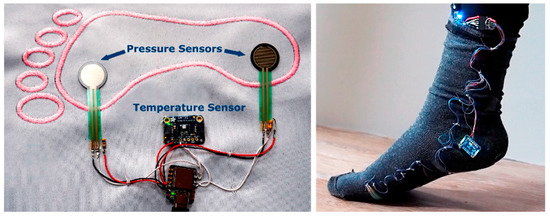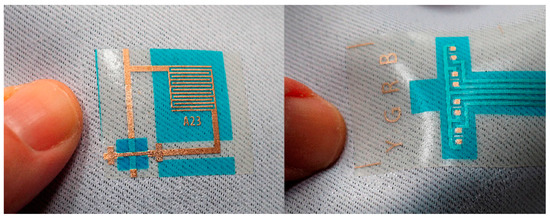Abstract
Touch Craft Ltd completed a feasibility study to understand the market position, technologies and user requirement for a smart sock sensing system designed to help monitor foot problems for people living with diabetes. The proposed system would involve a non-invasive, low-cost approach to gathering and measuring skin and foot data considering parameters such as pressure, temperature, and activity levels. The smart sock sensing system would enable both clinicians and patients to have a broader view of foot health and assist in improving the quality of life for patients and their carers.
1. Introduction
This paper describes a feasibility study undertaken by Touch Craft Ltd to develop a smart sock sensing system, which was supported by the Challenge Fund awarded by eHealth Productivity and Innovation in Cornwall and the Isles of Scilly [1]. The study was established to understand three key areas: the market position, technologies and user requirements for a smart sock sensing system that would be designed to help monitor foot problems.
The perspectives of clinical staff were critical in defining those people living with neuro-diabetes and foot problems as the patient population that would most benefit from a smart sock sensing system. The proposed system would help monitor foot problems in those people at high risk to help prevent ulcers and skin lesions as well as providing a foot management system to prevent re-ulceration. Healthcare professionals acknowledge the benefits of reducing foot pressures as a mechanism by which foot ulceration can be prevented [2]. Monitoring the temperature of the foot is an evidence-based preventive practice for patients at risk of diabetic foot complications [3]. The functionality of a smart sock would need to involve a non-invasive, low-cost approach to gathering and measuring skin and foot information involving pressure and temperature data.
2. Materials and Methods
The feasibility study adopted Public and Patient Involvement and Engagement as a method of engaging patients and public in the research, referencing values and principles that should be followed to reflect good practice and guide project development [4]. Additionally, interviews with medical specialists and healthcare professionals addressed requirements for a smart sock from a clinical perspective. There was agreement from clinicians around the type of data to capture, adherence and compliance issues and the identification of monitoring and rehabilitation as significant applications for assessing and treating patients.
The researcher used PPIE methods including questionnaires, interviews and group discussion to collect data from the Lay Panel at Barts Hospital in London. The group consists of 25 members made up of patients, nurses, voluntary representatives, and clinicians that meet quarterly to improve research for the benefit of people with diabetes, giving valuable on-line feedback to researchers and refining study design and delivery [5].
2.1. Preliminary Prototypes
Touch Craft Ltd worked with Marina Toeters from By-Wire.Net [6] to design and produce innovative textile prototypes as an initial proof of concept that demonstrated core functionality (see Figure 1). They were designed to collect, process and display pressure and temperature body data using off-the-shelf technologies to illustrate the possibilities of a wearable ‘smart sock’ to physiotherapists and orthopaedic clinicians.

Figure 1.
Preliminary prototypes.
Further funding would support the development of more refined, robust prototypes if the project were supported in future studies. At this stage, the preliminary prototypes are presented as rough sketches using ‘lo-fidelity’ technology to prompt discussion and help outline more specific features and functionality. A feasibility study was not extensive enough to test all the different fabrics and sensors that could be used to construct a smart sock. Prototyping helped the team understand the possibilities, limitations and outcomes that could then be experienced by clinicians and patient groups.
2.2. Printed Electronics
Printed electronics are part of an emerging market for flexible and printed sensors and components that are flexible and offer seamless integration. Printed electronics are usually screen-printed in multiple layers and fused onto fabric substrates. Touch Craft Ltd worked with Marina Toeters from the fashion and technology company By-Wire.Net [6] to demonstrate the viability of printed electronic components that could be included in future prototypes (see Figure 2).

Figure 2.
Printed electronics.
3. Results
A summary of themes that emerged from interviews and questionnaires are presented below and have been organised into sections depending on their overall theme.
3.1. Remote Consultations
- Patient groups wanted to maintain in-person consultations with clinical teams as a move against the increased interest in remote sensing and remote consultations.
- Patient groups were concerned that the increased prevalence of remote consultations would replace the foot health checks and examinations conducted by professionals using a variety of methods; e.g., filament, ultrasound, colour checks and circulation.
3.2. Foot Health, Mobility and Compliance
- The study highlighted a general lack of concern for foot health, not just in diabetic patients, and the technical difficulties involved in older adults monitoring their own foot issues.
- Clinicians were keen to stress the importance of patients taking a more active role to identify and deal with problems relating to their own foot health.
- Mobility is a crucial part of wellbeing and overall good health, and there was some concern that sensing technology embedded within a smart sock would not be able to detect mobility issues and alert patients.
- There was optimism among clinical professionals that the device (particularly temperature sensing) could have practical applications for remote monitoring and self-management of diabetic feet at risk of re-ulceration.
3.3. Practical Considerations, Design, Ergonomics and Fit
- Patient groups wanted a smart sock to be comfortable to wear and a good fit, preferably seamless, so that seams would not chafe on the toes.
- Patient groups requested more details on washing cycles and the standard length of time advised for smart sock use.
- Respondents questioned if the device would be suitable for wearing inside a shoe.
3.4. System Design, Technical Features and Data Transmission
- Many respondents wanted to know if a smart sock would be able to detect excesses of foot heat, cold, numbness, sweat, smell and fragrance.
- Patient groups were concerned with issues of intermittent signal or signal loss during data transmission or communication with clinicians.
- Respondents were keen to know more about the kind of feedback provided by the system to alert patients or clinicians, perhaps a ‘bleep’, an alarm or colour change on the sensor to indicate loss of feeling in the feet.
- Clinicians reported on the position and number of the pressure sensors on the foot. For more accurate pressure sensing, the sensors would need to be embedded across the whole forefoot.
3.5. Funding, Development and Future Studies
- Respondents raised concerns around the project being a beneficial investment and requested more information about methods of funding smart sock development.
4. Discussion
Many of the findings outlined themes that could be explored in future studies but were outside the scope of this limited feasibility study. Patient and clinical perspectives emphasized technical as well as practical elements, which emerged as strong themes and demonstrated a concern with the design of the sock to maximise comfort, fit and performance. More details were requested regarding the technical features and how these could be more seamlessly embedded into the sock. Much of the future work in this area would concentrate on integrating printed electronics that are discussed in Section 3.2.
What emerged from the feedback was that many of the respondents were interested in the idea of collecting foot information and biofeedback to indicate issues around foot health. Patients were particularly interested in the idea of exploring further the idea of developing a ‘digital health assistant’ that could support patients in managing their own foot care.
5. Conclusions
Patient feedback indicated that a future smart sock should not replace in-person consultations but would complement the personal, reassuring meetings with health professionals. This would be enhanced with data gathered from home monitoring and self-management of foot problems. This might include conducting virtual foot checks as well as regular manual foot checks to monitor changes and risk factors.
To conclude, it is worth noting that more robust, hi-fidelity prototypes would not have been produced at this stage in the development cycle. The feasibility study aimed to present information to support the proposition for the smart sock concept being technically and clinically viable and identifying patient support for the idea. The study was successful in determining a clinical and patient need for a smart sock sensing system and suggesting that further funding and research could progress the idea into a robust and beneficial product.
Funding
This project received a feasibility grant awarded by EPIC, eHealth Productivity and Innovation in Cornwall and the Isles of Scilly, funded by the European Regional Development Fund.
Institutional Review Board Statement
Ethical review and approval were waived for this study due to the restricted nature of the research methods adopted.
Informed Consent Statement
Patient consent was waived as it was categorised as involvement rather than research because it asked opinion to inform what was proposed rather than collecting study data.
Data Availability Statement
The data presented in this study are available on request from the corresponding author. The data are not publicly available due to the conditions of the funder.
Acknowledgments
The author would like to thank Joanne Paton, School of Health Professions, Faculty of Health: Medicine, Dentistry and Human Sciences, University of Plymouth.
Conflicts of Interest
The author declares no conflict of interest.
References
- eHealth Productivity and Innovation in Cornwall and the Isles of Scilly (EPIC). Available online: https://www.plymouth.ac.uk/research/epic (accessed on 1 December 2022).
- Collings, R.; Freeman, J.; Latour, J.M.; Paton, J. Footwear and insole design features for offloading the diabetic at risk foot—A systematic review and meta-analyses. Endocrinol. Diabetes Metab. 2020, 4, e00132. [Google Scholar] [CrossRef] [PubMed]
- Lavery, L.A.; Petersen, B.J.; Linders, D.R.; Bloom, J.D.; Rothenberg, G.M.; Armstrong, D.G. Unilateral remote temperature monitoring to predict future ulceration for the diabetic foot in remission. BMJ Open Diab. Res. Care 2019, 7, e000696. [Google Scholar] [CrossRef] [PubMed]
- INVOLVE. Values, Principles and Standards for Public Involvement in Research; INVOLVE: Eastleigh, UK, 2015. [Google Scholar]
- Diabetes Research Lay Panel. Available online: https://www.qmul.ac.uk/blizard/research/research-groups/barts-diabetes--obesity-research-group/diabetes-research-lay-panel/ (accessed on 2 December 2022).
- By-Wire.Net. Available online: https://www.by-wire.net/ (accessed on 28 November 2022).
Disclaimer/Publisher’s Note: The statements, opinions and data contained in all publications are solely those of the individual author(s) and contributor(s) and not of MDPI and/or the editor(s). MDPI and/or the editor(s) disclaim responsibility for any injury to people or property resulting from any ideas, methods, instructions or products referred to in the content. |
© 2023 by the author. Licensee MDPI, Basel, Switzerland. This article is an open access article distributed under the terms and conditions of the Creative Commons Attribution (CC BY) license (https://creativecommons.org/licenses/by/4.0/).